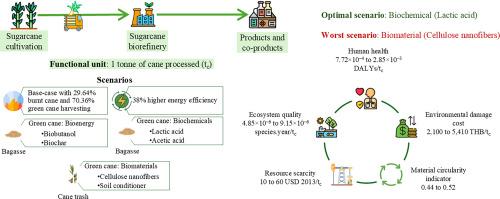Circular economy models of sugarcane biorefinery towards carbon neutrality and environmental sustainability
IF 9.6
1区 环境科学与生态学
Q1 ENVIRONMENTAL STUDIES
引用次数: 0
Abstract
Sugarcane biorefineries convert sugarcane waste into bioproducts, requiring assessment for environmentally viable processing. This study compared the life cycle environmental impacts, environmental damage costs, and circularity of sugarcane biorefinery scenarios: a base case with pre-harvest cane trash burning and sugar and ethanol production; a modified one with improved energy efficiency; and three bioproduct scenarios producing bagasse-based biobutanol or biochar for bioenergy scenario, lactic or acetic acid for biochemicals, and cane trash-derived cellulose nanofibers or soil conditioner for biomaterials. Bioproduct scenarios assumed green cane harvesting. Life cycle assessment followed a cradle-to-gate scope, with a functional unit of 1 tonne of cane processed (tc). Damage to human health ranged from 7.72 × 10−4 to 2.85 × 10−3 disability-adjusted life years/tc; ecosystem from 4.85 × 10−6 to 9.15 × 10−6 species.year/tc; resource scarcity from 10 to 60 United States dollar 2013/tc; total damage costs from 2,100 to 5,410 Thai Baht/tc, and circularity from 0.44 to 0.52. Bioproduct scenarios, except cellulose nanofibers, had lower environmental damage costs than the base case. Biorefinery circularity aligned closely with the highest-value product in each scenario. Biochemical (Lactic acid) was the best overall, with the lowest environmental damage cost and resource scarcity damage, relatively low human health and ecosystem damage, and a high circularity score of 0.5. Biomaterial (Cellulose nanofibers) was the worst due to its highest damage cost from the highest fossil resource scarcity, accounting for over 95 % of resources scarcity damage in all scenarios, and high-water consumption, despite minimum human health damage from the lowest fine particulate matter formation, leading contributor to human health damage mainly from cane burning and biomass electricity, and a high circularity of 0.52. The modified base case was slightly better than the base case across all metrics. Bioproduct scenarios increased circularity; however, higher circularity did not always correlate better environmental performance.

面向碳中和和环境可持续性的甘蔗生物炼制循环经济模式
甘蔗生物精炼厂将甘蔗废料转化为生物产品,需要对环境可行的加工进行评估。本研究比较了甘蔗生物炼制的生命周期环境影响、环境破坏成本和循环度:一个基本情况是收获前的甘蔗垃圾燃烧和糖和乙醇生产;改进型能源效率提高的改进型;还有三个生物产品方案,为生物能源方案生产甘蔗渣基生物丁醇或生物炭,为生物化学方案生产乳酸或乙酸,为生物材料生产甘蔗垃圾衍生的纤维素纳米纤维或土壤调节剂。生物产品假设是绿色甘蔗收割。生命周期评估遵循从摇篮到闸门的范围,以1吨甘蔗加工(tc)为功能单位。对人体健康的损害范围为7.72 × 10−4至2.85 × 10−3残疾调整生命年/tc;生态系统从4.85 × 10−6到9.15 × 10−6 species.year/tc;资源稀缺性从10美元到60美元2013/tc;总损害费用为2,100至5,410泰铢/tc,循环费用为0.44至0.52。除纤维素纳米纤维外,生物产品方案的环境破坏成本低于基本方案。在每种情况下,生物精炼循环与最高价值产品密切相关。生物化学(乳酸)整体效果最好,环境破坏成本和资源稀缺性损害最低,人体健康和生态系统损害相对较低,循环度评分较高,为0.5。生物材料(纤维素纳米纤维)是最糟糕的,因为化石资源最稀缺造成的损害成本最高,占所有情景中资源稀缺损害的95%以上;尽管细颗粒物形成对人类健康的损害最小,但耗水量高,主要来自甘蔗燃烧和生物质发电,对人类健康造成的损害最大,循环度高,为0.52。修改后的基本情况略好于所有指标的基本情况。生物产品情景增加循环;然而,更高的循环度并不总是与更好的环保性能相关。
本文章由计算机程序翻译,如有差异,请以英文原文为准。
求助全文
约1分钟内获得全文
求助全文
来源期刊

Sustainable Production and Consumption
Environmental Science-Environmental Engineering
CiteScore
17.40
自引率
7.40%
发文量
389
审稿时长
13 days
期刊介绍:
Sustainable production and consumption refers to the production and utilization of goods and services in a way that benefits society, is economically viable, and has minimal environmental impact throughout its entire lifespan. Our journal is dedicated to publishing top-notch interdisciplinary research and practical studies in this emerging field. We take a distinctive approach by examining the interplay between technology, consumption patterns, and policy to identify sustainable solutions for both production and consumption systems.
 求助内容:
求助内容: 应助结果提醒方式:
应助结果提醒方式:


